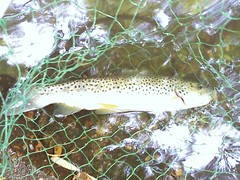As I indicated in my earlier post, trout rival bass for my enthusiasm. Unfortunately, eastern trout continue to be under threat. Unlike Bass, which are warmwater fish, trout are coldwater fish that require clear, highly oxygenated water. That creates problems here in the east where urbanization and warmer weather threatens habitat that once supported large numbers of brook trout.
The state of native brook trout puts pressure on fishery biologists to manage potential competitors such as brown trout. In the Shenendoah National Park new regulations seek to purge browns in defense of the brookie. In the few waters this far south that support wild brook trout that is probably the right solution. But what about lower elavations where trout typically do not hold through the summer? In this area the state stocks mainly Rainbows which are then harvested by anglers before the water is too warm to support them. But some of these waters are ground fed and have far lower water temperatures than many realize. Here in the DC suburbs of VA I bagged trout in late June last year when they should have been long gone. But what if instead of stocking mainly rainbows the state stocked browns? Brown trout can survive in water that is warmer and more turbid than their rainbow cousins. Browns hold successfully in streams just north of us in Montgomery, and Baltimore County, MD. Gunpower Falls provides a tailwater habitat that browns thrive in, but the water is admittedly much cooler than typically found here in Virginia.
My suspicion is that biologists are hesitant to stock browns because they are non-native to North America. Unlike Rainbows that are native to the west coast, browns were brought by European settlers. In many cases they do threaten native brook trout. But in areas where brook trout can not survive, they may be far less invasive. Streams that are ground or dam fed may allow browns to hold where rainbows will not. If these fish are successfully introduced they can provide a vehicle for stream restoration. Restoration efforts may include a buffer of trees, a stream clean up, or efforts to contain residential drainage. Any reasons why the brown trout is invasive can be offset by protecting the stream from pollution and urban run off. I am sure there are many other factors to look at but it is worth considering using brown trout to reclaim mid-atlantic streams and surrounding habitat that may be otherwise threatened. Here in the Chesapeake watershed it may be a baby step toward addressing a larger problem.
Ok, that may be an ironic conclusion on a blog named "Bass Slayer." I would like to point out I don't actually slay the bass, I practice catch and release...and I want to catch bass and trout when I retire. That is a long way away so we need better conservation or the only thing I will catch is some mysterious illness
Saturday, January 19, 2008
Subscribe to:
Post Comments (Atom)


1 comment:
I probably should mention that it is more than holding over. All trout require clean gravel with sufficient current to spawn. This is unlikely in the Potomac tidal basin, but along the fall line it may be possible. Seneca creek outside Gaithersburg, MD (DC suburb) has a tributary that sustains browns. Gaithersburg straddles the fall line. Of course, Seneca creek is stocked primarily with rainbows.
Post a Comment